Related Reading
When do you know concrete is dry? The answer to this million – perhaps billion – dollar question is...it depends, and it depends who you ask. If you question a concrete expert, a restoration technician and a floor-covering contractor, you might get similar responses, but you’re just as likely to get three completely different answers.
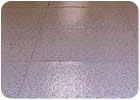 I began searching for the answer almost 26 years ago, and my quest continues to this day. My passion for concrete came at a young age, when the little bugger seemed to start controlling my fate more than ever before, as our floor covering installations started to fail as a result of moisture. Prior to this, I’d been safe and happy for years. But when EPA regulations were implemented, and the budget considerations and fast-track construction of the late 80s came into play, installations that once worked no longer sufficed. As I’ve searched through the years I’ve found comfort in knowing I was in good and brilliant company, but you would think that, after decades of study and analysis, we would be closer to some firm answer.
I began searching for the answer almost 26 years ago, and my quest continues to this day. My passion for concrete came at a young age, when the little bugger seemed to start controlling my fate more than ever before, as our floor covering installations started to fail as a result of moisture. Prior to this, I’d been safe and happy for years. But when EPA regulations were implemented, and the budget considerations and fast-track construction of the late 80s came into play, installations that once worked no longer sufficed. As I’ve searched through the years I’ve found comfort in knowing I was in good and brilliant company, but you would think that, after decades of study and analysis, we would be closer to some firm answer.
The goal here is to point out how one of the most moisture-sensitive construction materials – both during construction and in rewetting conditions, such as a flood – is so misunderstood and overlooked, sometimes dangerously so, when it comes to drying.
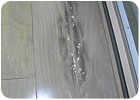 Fortunately, I have always been of the belief that, if you can’t beat them, certainly don’t join them, but instead find out why you can’t beat them. Unfortunately, though, at the end of the day most of what I’ll give you will result in more questions than answers, but this is not always a bad thing. If we keep asking questions and comparing notes, perhaps one day we will find the “magic” answer. In that vein, let’s examine some related research and the posture of various industries on concrete and concrete drying.
Fortunately, I have always been of the belief that, if you can’t beat them, certainly don’t join them, but instead find out why you can’t beat them. Unfortunately, though, at the end of the day most of what I’ll give you will result in more questions than answers, but this is not always a bad thing. If we keep asking questions and comparing notes, perhaps one day we will find the “magic” answer. In that vein, let’s examine some related research and the posture of various industries on concrete and concrete drying.
Of the various building materials, concrete has the potential to be one of the most frustrating sources of moisture, especially after the drying process is “considered” complete and the concrete is covered with a floor covering material with low permeability. Concrete is often viewed as a less porous, consistent, predictable and non-absorptive type material when compared with other building materials. This incorrect perception often leads to concrete being overlooked in the drying process and, as a result, can lead to replenishment of moisture, floor failure and, worse still, a source of moisture for mold.
First and foremost, you must realize that no concrete is created equal, and in no way should it be compared to a consistently produced structural material, such as drywall. Here are a few facts to remember when placing, testing, covering and/or restoring concrete:
- Newly made concrete is physically not the same material as mature concrete¹
- Concrete slabs can be replenished with moisture after drying if no vapor retarder/barrier is present, or if it has been damaged in some way
- Concrete in itself is not damaged by having high moisture states. However, the concrete absorption and divergence in drying rate can be affected by hydration, carbonation, chemical composition, porosity and permeability.
- Concrete maturation also affects and changes the ability of concrete to transport water (moisture permeability). This is one explanation for the distinction which must be made between drying construction water and drying mature concrete (e.g., after water damage). ²
 Gorhan Hedenblad reports some very informative findings in his research, done through the Swedish Council of Research in 1993 and 1997, demonstrating the effect these characteristics have on the time required to dry construction water in concrete and after water damage. Some of Hedenblad’s studies involved 4-inch-thick concrete slabs drying from one side (this case applies to sealed concrete slab on the ground, e.g. vapor retarder/barrier, but also to concrete floors cast on impervious permanent formwork (e.g. decking) exposed in a room at 50-percent RH and 70° F.) Based on that research, he developed a method for estimating drying time using correction factors to account for one- or two- sided drying, and variations in slab thickness, curing conditions, temperature and RH during drying.
Gorhan Hedenblad reports some very informative findings in his research, done through the Swedish Council of Research in 1993 and 1997, demonstrating the effect these characteristics have on the time required to dry construction water in concrete and after water damage. Some of Hedenblad’s studies involved 4-inch-thick concrete slabs drying from one side (this case applies to sealed concrete slab on the ground, e.g. vapor retarder/barrier, but also to concrete floors cast on impervious permanent formwork (e.g. decking) exposed in a room at 50-percent RH and 70° F.) Based on that research, he developed a method for estimating drying time using correction factors to account for one- or two- sided drying, and variations in slab thickness, curing conditions, temperature and RH during drying.
In Hedenblad’s research, an 85-percent RH was measured at a depth equal to 40 percent of the slab thickness.³ The 40 percent was derived from his studies on the moisture profile before drying, after drying, and the moisture profile after laying floor covering and the redistribution of the moisture below it. Eighty-five percent and below is considered a safety margin between the critical RH and the actual RH and, at least based on most European standards, the most critical moisture levels for most floor covering should be no higher than 80 percent to 85 percent (in the ASTM F-710-05 “Standard Practice for Preparing Concrete Floors to Receive Resilient Flooring,” in lieu of any stated floor covering manufacturers’ recommendations, it recommends an internal RH of 75 percent to receive resilient flooring.)
Keep in mind, these results reflect a presence of some form of a vapor retarder/barrier, and cannot be applied if one is not present. The studies reported in 1997 involved testing the drying time of newly placed concrete; the ones reported in 1993 involved testing well-hydrated concrete specimens more than a year old. In one study, after rewetting and saturating mature concrete specimens of different thicknesses and water-cement ratios, these specimens were allowed to dry at a “standard case” 50 percent relative humidity and 70°F. In this study, a chart of correction factors due to another RH in the drying climate is presented. Various charts and description of findings of the different case studies involving varying slab thicknesses, quality, point of measurement and one-sided and two-sided etc. are illustrated in both studies.
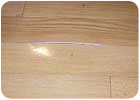 Interestingly, one case study found it took rewetted, mature concrete with a water-cement ratio of 0.07, drying from one side 515 days, to reach 85% internal RH.5To reach the same RH level, newly placed concretes with the same water-cement ratio took 184 days when cured for one day, and 258 days when cured for 28 days (four weeks).6 For purposes, of these various studies, the mature concrete was either fully capillary saturated or saturated to 95 percent. That is, when the drying starts the whole concrete structure is filled with water, or else the whole concrete structure is 95 percent RH. Hedenblad also illustrates a case study performed on a concrete floor construction with a variable moisture profile. A part of the concrete (X) is fully capillary saturated when the drying starts; in the rest of the concrete RH is 60 percent. The slab is 175mm thick. When the drying starts, the moisture in the concrete structure is distributed differently in the structure, e.g. a concrete floor construction where there has been a water leakage on the top for a short time, e.g. from a fire being extinguished. The data was not as exact as in the previous cases, and is presented in curves instead of numbers. What is illustrated, though, is that the necessary drying time, as a function of the position of the moisture boundary, was still approximately 140 days, which is approximately 25 percent of the time it takes to reach 85 percent at close to 40 percent under an impermeable floor covering material, as it did when fully capillary saturated. 7
Interestingly, one case study found it took rewetted, mature concrete with a water-cement ratio of 0.07, drying from one side 515 days, to reach 85% internal RH.5To reach the same RH level, newly placed concretes with the same water-cement ratio took 184 days when cured for one day, and 258 days when cured for 28 days (four weeks).6 For purposes, of these various studies, the mature concrete was either fully capillary saturated or saturated to 95 percent. That is, when the drying starts the whole concrete structure is filled with water, or else the whole concrete structure is 95 percent RH. Hedenblad also illustrates a case study performed on a concrete floor construction with a variable moisture profile. A part of the concrete (X) is fully capillary saturated when the drying starts; in the rest of the concrete RH is 60 percent. The slab is 175mm thick. When the drying starts, the moisture in the concrete structure is distributed differently in the structure, e.g. a concrete floor construction where there has been a water leakage on the top for a short time, e.g. from a fire being extinguished. The data was not as exact as in the previous cases, and is presented in curves instead of numbers. What is illustrated, though, is that the necessary drying time, as a function of the position of the moisture boundary, was still approximately 140 days, which is approximately 25 percent of the time it takes to reach 85 percent at close to 40 percent under an impermeable floor covering material, as it did when fully capillary saturated. 7
What does this tell us? According to Hedenblad, the general conclusion of the calculations is that it often takes so long that practical drying of the structure may be hard to do. This is especially true when moistening has been going on for a long time and a lot of water has been added to the construction.8 One possible course of action may be to first dry the concrete in a shorter period using various mechanical forced-drying techniques (such as with air movement, hot air drying and/or desiccant dehumidifiers) and/or consider applying or installing a moisture barrier between the concrete and the moisture-sensitive floor covering material.
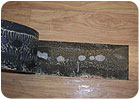 But how can you determine what course of drying and restorative action can be done, or if the actions taken even worked, if you do not pre- and post-test the concrete? In this instance a concrete moisture meter, if it works at all, will provide you strictly with qualitative comparative readings and will not aid in establishing quantitative concrete drying goals. Meters can also be skewed by surface moisture and concrete salts.
But how can you determine what course of drying and restorative action can be done, or if the actions taken even worked, if you do not pre- and post-test the concrete? In this instance a concrete moisture meter, if it works at all, will provide you strictly with qualitative comparative readings and will not aid in establishing quantitative concrete drying goals. Meters can also be skewed by surface moisture and concrete salts.
Which leads to this: what is the best quantitative test for helping establish drying goals for concrete? Doing nothing because of time constraints or lack of knowledge is not an answer (well, it is, but it’s a really bad one). First, the best offense is always a good defense. Taking the time to educate yourself and gain a better understanding of what the applicable industry has to offer is, for the time being, the only thing that can be done.
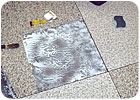 In the United States, moisture-vapor emission rates (MVER) have been measured following the ASTM-F1869-04 “Standard Test Method for Measuring Moisture Vapor Emission Rate of Concrete Subfloor Using Anhydrous Calcium Chloride” instead of the ASTM F2170-02 “Standard Test Method for Determining Relative Humidity in Concrete Floor Slabs Using In-Situ Probes.” The U.S. is the only country in the world that uses this test to measure the moisture condition of concrete. We are now being shown through numerous articles and some research that this information might be misleading, in that it provides us with a snapshot or indication of moisture present in only the top 1/2 to 3/4 inch (13mm to 19 mm) of the slab, not down in the concrete gradient as internal RH testing provides.9 Research performed by H.W. Brewer in 1965 shows that freshly placed concrete specimens dried from one side at 73°F and 50 percent RH, with a water-cement ratio of .70, and cured for seven days, took 130 days to reach 3 pounds/1000 square feet/24 hrs. Keep in mind, this is if the concrete has a vapor retarder/barrier present and does not get rewetted during construction and/or from a flood. If it does, then the drying clock starts all over. 10
In the United States, moisture-vapor emission rates (MVER) have been measured following the ASTM-F1869-04 “Standard Test Method for Measuring Moisture Vapor Emission Rate of Concrete Subfloor Using Anhydrous Calcium Chloride” instead of the ASTM F2170-02 “Standard Test Method for Determining Relative Humidity in Concrete Floor Slabs Using In-Situ Probes.” The U.S. is the only country in the world that uses this test to measure the moisture condition of concrete. We are now being shown through numerous articles and some research that this information might be misleading, in that it provides us with a snapshot or indication of moisture present in only the top 1/2 to 3/4 inch (13mm to 19 mm) of the slab, not down in the concrete gradient as internal RH testing provides.9 Research performed by H.W. Brewer in 1965 shows that freshly placed concrete specimens dried from one side at 73°F and 50 percent RH, with a water-cement ratio of .70, and cured for seven days, took 130 days to reach 3 pounds/1000 square feet/24 hrs. Keep in mind, this is if the concrete has a vapor retarder/barrier present and does not get rewetted during construction and/or from a flood. If it does, then the drying clock starts all over. 10
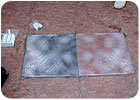 Making an attempt during testing to find out if a moisture vapor/barrier/retarder is in existence, as well as discovering any other pertinent information that might help with establishing concrete drying goals, is highly recommended. Remember, with no retarder/barrier in place, there are no guarantees that the concrete will ever dry, or even stay dry at a specified critical zone to receive floor coverings. This information would also help if it is shared with the end user before drying and/or installation of the floor coverings begins. Hedenblad goes so far as to put a warning in his published research that drying by way of heating the floor can result in the ground getting heated. When the heating ceases, moisture can be transported from the ground to the concrete. As a matter of fact, when the concrete is lying directly on the ground, it is not possible do any calculations of the drying time. This is because moisture is normally transported from the ground to concrete. The amount of transported moisture varies, depending on the type of ground and ground water levels. 11
Making an attempt during testing to find out if a moisture vapor/barrier/retarder is in existence, as well as discovering any other pertinent information that might help with establishing concrete drying goals, is highly recommended. Remember, with no retarder/barrier in place, there are no guarantees that the concrete will ever dry, or even stay dry at a specified critical zone to receive floor coverings. This information would also help if it is shared with the end user before drying and/or installation of the floor coverings begins. Hedenblad goes so far as to put a warning in his published research that drying by way of heating the floor can result in the ground getting heated. When the heating ceases, moisture can be transported from the ground to the concrete. As a matter of fact, when the concrete is lying directly on the ground, it is not possible do any calculations of the drying time. This is because moisture is normally transported from the ground to concrete. The amount of transported moisture varies, depending on the type of ground and ground water levels. 11
After confirming if a vapor retarder/barrier is present, it’s time to test. If there is no control area available, you will have to test the concrete that has been flooded. The calcium chloride tests are more sensitive and can be affected by moisture on the slab surface and/or certain variances in temperature and/or humidity. If you are going to do RH testing, make sure the holes you drill are dry and free of concrete dust and debris. Be careful with your testing sensors; they can be affected by some drying procedures. Depending on the drying circumstances, it might be best to drill the holes, cap them and wait 72 hours prior to placing the sensors. Unfortunately, doing so eliminates the ability to perform data logging and monitoring during certain drying processes. Most importantly, for both tests, get a copy of the ASTM’s testing standards and follow the testing procedures listed there.
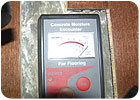 As far as the test results go, how do we know the concrete is dry and ready to receive floor covering? My answer to that is, again...wait for it…it depends. The studies cited here help support that the critical number, as far as the installation of floor covering goes, is internal RH. We are also being shown that the MVER might not be giving us all of the information we need to know when the concrete redistributes moisture after being covered with a low-permeance floor covering.
As far as the test results go, how do we know the concrete is dry and ready to receive floor covering? My answer to that is, again...wait for it…it depends. The studies cited here help support that the critical number, as far as the installation of floor covering goes, is internal RH. We are also being shown that the MVER might not be giving us all of the information we need to know when the concrete redistributes moisture after being covered with a low-permeance floor covering.
We have been shown that 3 pounds might not be able to be achieved, and to date we have no solid data to show a correlation between MVER and internal RH in concrete. Some studies have shown that the calcium chloride tests can be affected by temperature and humidity and can possibly be affected if administered during the drying process. The RH tests can provide us with information before, during and after the drying process, which can only help us to make a better determination if the concrete is dry and ready to receive floor covering of any type.
This is all very good news, but unfortunately not enough studies have been done in order to provide us with the answer to the question; in fact, it may have given you cause to question the answers (I did warn that this might happen). That’s just as good; if enough of us keep asking why, perhaps we can get to the answer sooner than later. While you might not have the obligation to ward off all moisture replenishment from concrete after it is placed and/or after it rewets, you do have the professional responsibility to at least understand that concrete is a unique building material, needs to be tested and should not be taken lightly when it is being dried or covered.
[1] Goran Hedenblad, Drying Times for Concrete after Water Damage” (English Translation), The Swedish Council for Building Research, 1993.
[2] Goran Hedenblad, Drying Times for Concrete after Water Damage” (English Translation), The Swedish Council for Building Research, 1993.
[3] Bruce A Suprenant, and Ward R Malisch, “Why won’t the concrete dry?”, Publication #C99G029 Copyright(c) 1999, The Aberdeen group a division of Hanley-Wood, Inc.
[4]Bruce A Suprenant, and Ward R Malisch, “Why won’t the concrete dry?”, Publication #C99G029 Copyright(c) 1999, The Aberdeen group a division of Hanley-Wood, Inc., Bruce A Suprenant,and Ward R Malisch, “Why won’t the concrete dry?”, Publication #C99G029 Copyright(c) 1999, The Aberdeen group a division of Hanley-Wood, Inc., Goran Hedenblad, “Drying of Construction Water in concrete,” Swedish council for Building Research, 1997, available form the Portland Cement Association, Skokie, Ill, Goran Hedenblad, “Concrete Drying Time, “Concrete Technology Today, July 1998, Portland Cement Association.
[5] Goran Hedenblad, Drying Times for Concrete after Water Damage” (English Translation), The Swedish Council for Building Research, 1993
[6] Goran Hedenblad, “Drying of Construction Water in concrete,” Swedish council for Building Research, 1997, available form the Portland Cement Association, Skokie, Ill, Goran Hedenblad, “Concrete Drying Time, “Concrete Technology Today, July 1998, Portland Cement Association.
[7]
[8] Goran Hedenblad, Drying Times for Concrete after Water Damage” (English Translation), The Swedish Council for Building Research, 1993
[9] Peter Craig and George Donnelly, “Moisture Testing of Concrete Slabs, When 3lbs. is not 3lbs.” Concrete International, September 2006. Bruce A Supernant and Ward Malish, “Are your slabs dry enough for floor coverings?”, Publication #C980671 Copyright (c) 1998, The Aberdeen Group, Bruce A. Supernant, “Design of Slabs that Receive Moisture-Sensitive Floor Coverings Part One and Part Two, Concrete International March 2003 &April 2003. Bruce A. Suprenant, “Use and Misuse of Moisture-Vapor Emission , Concrete International, December 2003
[10] Brewer, H.W.,”Moisture Migration-Concrete Slab-On-Ground Construction, “Bulletin D89, Portland Cement Association, Skokie, Il. May 1965. Bruce A. Suprenant, “Moisture Movement Through Concrete Slags”, Concrete Construction, November 1997.
[11] Goran Hedenblad, “Drying of Construction Water in concrete,” Swedish council for Building Research, 1997, available form the Portland Cement Association, Skokie, Ill, Goran Hedenblad,

